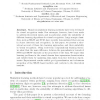Free Online Productivity Tools
i2Speak
i2Symbol
i2OCR
iTex2Img
iWeb2Print
iWeb2Shot
i2Type
iPdf2Split
iPdf2Merge
i2Bopomofo
i2Arabic
i2Style
i2Image
i2PDF
iLatex2Rtf
Sci2ools
106
click to vote
ECCV
2002
Springer
2002
Springer
A Tale of Two Classifiers: SNoW vs. SVM in Visual Recognition
Numerous statistical learning methods have been developed for visual recognition tasks. Few attempts, however, have been made to address theoretical issues, and in particular, study the suitability of different learning algorithms for visual recognition. Large margin classifiers, such as SNoW and SVM, have recently demonstrated their success in object detection and recognition. In this paper, we present a theoretical account of these two learning approaches, and their suitability to visual recognition. Using tools from computational learning theory, we show that the main difference between the generalization bounds of SVM and SNoW depends on the properties of the data. We argue that learning problems in the visual domain have sparseness characteristics and exhibit them by analyzing data taken from face detection experiments. Experimental results exhibit good generalization and robustness properties of the SNoW-based method, and conform to the theoretical analysis.
Computational Learning Theory | Computer Vision | ECCV 2002 | Generalization Bounds | Large Margin Classifiers | Numerous Statistical Learning | Visual Recognition Tasks |
| Added | 16 Oct 2009 |
| Updated | 16 Oct 2009 |
| Type | Conference |
| Year | 2002 |
| Where | ECCV |
| Authors | Ming-Hsuan Yang, Dan Roth, Narendra Ahuja |
Comments (0)

